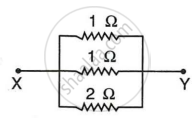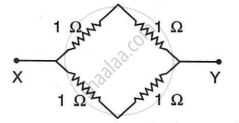Advertisements
Online Mock Tests
Chapters
1: Force
2: Work, Energy and Power
3: Machines
LIGHT
4: Refraction of Light at Plane Surfaces
5: Refraction through a Lens
6: Spectrum
SOUND
7: Sound
ELECTRICITY AND MAGNETISM
▶ 8: Current Electricity
9: Household Circuits
10: Electro-Magnetism
HEAT
11: Calorimetry
MODERN PHYSICS
12: Radioactivity
![Selina solutions for Physics [English] Class 10 ICSE chapter 8 - Current Electricity Selina solutions for Physics [English] Class 10 ICSE chapter 8 - Current Electricity - Shaalaa.com](/images/physics-english-class-10-icse_6:4c973dd038c545c9a2b6db170ad2f542.jpg)
Advertisements
Solutions for Chapter 8: Current Electricity
Below listed, you can find solutions for Chapter 8 of CISCE Selina for Physics [English] Class 10 ICSE.
Selina solutions for Physics [English] Class 10 ICSE 8 Current Electricity EXERCISE - 8(A) [Pages 186 - 187]
Define the term current.
State the S.I. unit of current.
Define the term potential difference.
State the S.I. unit of electric potential.
How is the electric potential difference between the two points defined? State its S.I. unit.
Explain the statement ‘the potential difference between two points is 1 volt’.
State whether the current is a scalar or vector?
What does the direction of current convey?
State whether the potential is a scalar or vector?
What does the positive and negative sign of potential convey?
Define the term resistance.
- Name the particles which are responsible for the flow of current in a metallic wire.
- Explain the flow of current in a metallic wire on the basis of movement of the particles named by you above in part (a).
- What is the cause of resistance offered by the metallic wire in the flow of current through it?
State Ohm’s law and draw a neat labelled circuit diagram containing a battery, a key, a voltmeter, an ammeter, a rheostat and an unknown resistance to verify it.
- Name and state the law which relates the potential difference and current in a conductor.
- What is the necessary condition for a conductor to obey the law named above in part (a) ?
- Draw a V-I graph for a conductor obeying Ohm’s law.
- What does the slope of V–I graph for a conductor represent?
Draw a I–V graph for a linear resistor. What does its slope represent?
What is an ohmic resistor? Give one example of an ohmic resistor. Draw a graph to show its current voltage relationship. How is the resistance of the resistor determined from this graph?
What are non-ohmic reistors? Give one example and draw a graph to show its current-voltage relationship.
Give two difference between an ohmic and non-ohmic resistor.
The following figure shows the I-V characteristic curves for two resistors. Identify the ohmic and non-ohmic resistors. Give a reason for your answer.
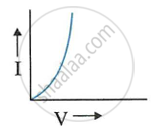 |
 |
| (a) | (b) |
Draw a V-I graph for a conductor at two different temperatures. What conclusion do you draw from your graph for the variation of resistance of conductor with temperature?
How does the resistance of a wire depend on its radius? Explain your answer.
Two copper wires are of the same length, but one is thicker than the other. Which wire will have more resistance?
How does the resistance of a wire depend on its length? Give a reason for your answer.
How does the resistance of a metallic wire depend on its temperature? Explain with reason.
Two wires, one of copper and other of iron, are of the same length and same radius. Which will have more resistance? Give reason.
Name three factors on which resistance of a given wire depends and state how is it affected by the factors stated by you.
Define specific resistance.
Write an expression connecting the resistance of a wire and specific resistance of its material. State the meaning of symbols used.
State the order of specific resistance of a metal.
State the order of specific resistance of a semiconductor.
State the order of specific resistance of an insulator.
Name two factors on which the specific resistance of a wire depends?
Two wires A and B are made of copper. The wire A is long and thin, while the wire B is short and thick. Which will have more specific resistance?
Name a substance which the specific resistance remains almost unchanged by the increase in temperature.
How does specific resistance of a semi-conductor change with the increase in temperature?
How does (a) resistance, and (b) specific resistance of a wire depend on its (i) length, and (ii) radius?
Name the material used for making the connection wires. Give a reason for your answer.
Why should a connection wire be thick?
Name a material which is used for making the standard resistor. Give a reason for your answer.
Name the material used for making a fuse wire. Give a reason.
Name the material used for filament of an electric bulb.
Name the material used for heating element of a room heater.
What is a superconductor?
Give one example of superconductor.
A substance has zero resistance below 1 k. What is such a substance called?
MULTIPLE CHOICE TYPE
Which of the following is an ohmic resistance?
LED
Junction diode
Filament of a bulb
Nichrome wire
For which of the following substance, resistance decreases with increase in temperature?
Copper
Mercury
Carbon
Platinum
NUMERICALS
In a conductor 6.25 × `10^16` electrons flow from its end A to B in 2 s. Find the current flowing through the conductor (e = 1.6 × `10^-19` C)
A current of 3.2 mA flows through a conductor. If charge on an electron is - 1.6 × 10-19 coulomb, find the number of electrons that will pass each second through the cross section of that conductor.
Find the potential difference required to flow a current of 300 mA in a wire of resistance 20 Ω.
An electric bulb draws 1.2 A current at 6.0 V. Find the resistance of filament of bulb while glowing.
A car bulb connected to a 12 volt battery draws 2 A current when glowing. What is the resistance of the filament of the bulb? Will the resistance be more same or less when the bulb is not glowing?
Calculate the current flowing through a wire of resistance 5 Ω connected to a battery of potential difference 3 V.
In an experiment of verification of Ohm’s law following observations are obtained.
|
Potential difference V (in volt) |
0.5 | 1.0 | 1.5 | 2.0 | 2.5 |
| current I (in ampere) | 0.2 | 0.4 | 0.6 | 0.8 | 1.0 |
Draw a V-I graph and use this graph to find:
- the potential difference V when the current I is 0.5 A,
- the current I when the potential difference V is 0.75 V,
- the resistance in a circuit.
Two wires of the same material and same length have radii 1 mm and 2 mm respectively. Compare their resistances.
Two wires of the same material and same length have radii 1 mm and 2 mm respectively. Compare their specific resistance.
A given wire of resistance 1 Ω is stretched to double its length. What will be its new resistance?
A wire of resistance 3 ohm and length 10 cm is stretched to length 30 cm. Assuming that it has a uniform cross section, what will be its new resistance?
A wire of resistance 9 ohm having length 30 cm is tripled on itself. What is its new resistance?
What length of copper wire of specific resistance 1.7 × 10-8 Ω m and radius 1 mm is required so that its resistance is 2 Ω?
The filament of a bulb takes a current 100 mA when potential difference across it is 0.2 V. When the potential difference across it becomes 1.0 V, the current becomes 400 mA. Calculate the resistance of filament in each case and account for the difference.
Selina solutions for Physics [English] Class 10 ICSE 8 Current Electricity EXERCISE - 8(B) [Pages 200 - 203]
Explain the meaning of the term e.m.f. of a cell.
Explain the meaning of the term terminal voltage of a cell.
Explain the meaning of the term internal resistance of a cell.
State two differences between the e.m.f and terminal voltage of a cell.
Name two factors on which the internal resistance of a cell depends and state how does it depend on the factors stated by you.
A cell of e.m.f ε and internal resistance r is used to send current to an external resistance R. Write expressions for
- the total resistance of circuit.
- the current drawn from the cell.
- the p.d. across the cell.
- voltage drop inside the cell.
A cell is used to send current to an external circuit.
- How does the voltage across its terminals compare with its e.m.f.?
- Under what condition is the e.m.f. of a cell equal to its terminal voltage?
Explain why the p.d across the terminals of a cell is more in an open circuit and reduced in a closed circuit.
Write the expressions for the equivalent resistance R of three resistors R1, R2 and R3 joined in
- parallel
- series
How would you connect two resistors in series? Draw a diagram. Calculate the total equivalent resistance.
Show by a diagram how two resistors R1 and R2 are joined in parallel. Obtain an expression for the total resistance of the combination.
State how are the two resistors joined with a battery when same current flows in each resistor.
State how are the two resistors joined with a battery when potential difference is same across each resistor.
State how are the two resistors joined with a battery when equivalent resistance is less than either of the two resistances.
State how are the two resistors joined with a battery when equivalent resistance is more than either of the two resistances.
The V-I graph for a series combination and for a parallel combination of two resistors is shown in the figure below. Which of the two A or B. represents the parallel combination? Give reasons for your answer.
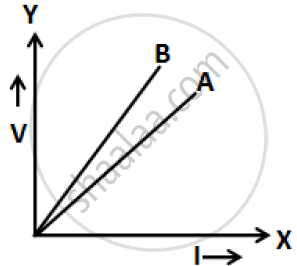
MULTIPLE CHOICE TYPE
In series combination of resistances ______.
p.d. is same across each resistance
total resistance is reduced
current is same in each resistance
all of the above are true
In parallel combination of resistances ______.
p.d. is same across each resistance
total resistance is increased
current is same in each resistance
all of the above are true
Which of the following combinations have the same equivalent resistance between X and Y?
NUMERICALS
The diagram in Figure shows a cell of e.m.f. ε = 4 volt and internal resistance r = 2 ohm connected to an external resistance R = 8 ohm. The ammeter A measures the current in the circuit and the voltmeter V measures the terminal voltage across the cell. What will be the readings of the ammeter and voltmeter when
- the key K is open, and
- the key K is closed
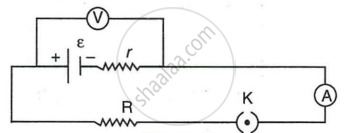
A battery of e.m.f. 6·0 V supplies current through a circuit in which the resistance can be changed. A high resistance voltmeter is connected across the battery. When the current is 3 A, the voltmeter reads 5.4 V. Find the internal resistance of the battery.
A cell of e.m.f. 1.8V and internal resistance 2Ω is connected in series with an ammeter of resistance 0.7Ω and a resistor of 4.5Ω as shown in Fig.
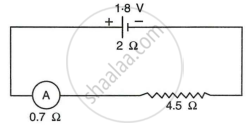
- What would be the reading of the ammeter?
- What is the potential difference across the terminals of the cell?
The music system draws a current of 400 mA when connected to a 12 V battery.
- What is the resistance of the music system?
- The music system if left playing for several hours and finally the battery voltage drops and the music system stops playing when the current drops to 320 mA. At what battery voltage does the music system stop playing?
A cell of e.m.f. ε and internal resistance 𝔯 sends current 1.0 A when it is connected to an external resistance 1.9 Ω. But it sends current 0.5 A when it is connected to an external resistance 3.9 Ω. Calculate the values of ε and 𝔯.
Two resistors having resistance 8 Ω and 12 Ω are connected in parallel. Find their equivalent resistance.
Four resistors each of resistance 5 Ω are connected in parallel. What is the effective resistance?
You have three resistors of values 2 Ω, 3 Ω, and 5 Ω. How will you join them so that the total resistance is less than 1 Ω? Draw a diagram and find the total resistance.
Three resistors each of 2 Ω are connected together so that their total resistance is 3 Ω. Draw a diagram to show this arrangement and check it by calculation.
Calculate the equivalent resistance between the points A and B in Fig. if each resistance is 2·0 Ω.

In the circuit shown below in Fig, calculate the value of x if the equivalent resistance between A and B is 4 Ω.

Calculate the effective resistance between the points A and B in the circuit shown in Figure.
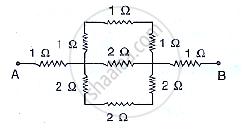
A uniform wire with a resistance of 27 Ω is divided into three equal pieces and then they are joined in parallel. Find the equivalent resistance of the parallel combination.
A circuit consists of a resistor of 1 ohm in series with a parallel arrangement of resistors of 12 ohm and 6 ohm. Calculate the total resistance of the circuit. Draw a diagram of the arrangement.
Calculate the effective resistance between the points A and B in the network shown below in figure.

Calculate the equivalent resistance between the points A and B in Fig.
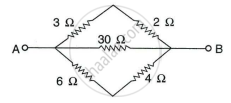
In the network shown in the following adjacent Figure, calculate the equivalent resistance between the points.
- A and B
- A and C
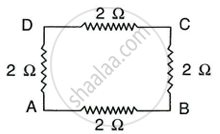
Five resistors, each 3 Ω, are connected as shown in Fig. Calculate the resistance
- between the points P and Q.
- between the points X and Y.

Two resistors of 4·0 Ω and 6·0 Ω are connected
- in series,
- in parallel, with a battery of 6·0 V and negligible internal resistance.
For each case draw a circuit diagram and calculate the current through the battery.
A resistor of 6 Ω is connected in series with another resistor of 4 Ω. A potential difference of 20 V is applied across the combination. Calculate
- the current in the circuit and
- the potential difference across the 6 Ω resistor.
Two resistors of resistances 2 Ω and 3 Ω are connected in parallel to a cell to draw current 0.5 A from the cell. Draw a labelled diagram of the arrangement
Two resistors of resistance 2 Ω and 3 Ω are connected in parallel to a cell to draw current 0.5 A from the cell. Calculate the current in each resistor.
Calculate the current flowing through each of the resistors A and B in the circuit shown in the following figure.

In the following figure calculate:
- the total resistance of the circuit
- the value of R, and
- the current flowing in R.
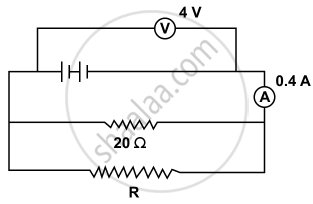
A particular resistance wire has a resistance of 3 ohm per meter. Find the total resistance of three lengths of this wire each 1.5 m long, joined in parallel.
A particular resistance wire has a resistance of 3 ohm per meter. Find the potential difference of the battery which gives a current of 2 A in each of the 1.5 m length when connected in the parallel to the battery (assume that resistance of the battery is negligible).
A particular resistance wire has a resistance of 3·0 ohm per metre. Find the resistance of 5 m length of a wire of the same material, but with twice the area of cross section.
A cell supplies a current of 1.2 A through two 2Ω resistors connected in parallel. When the resistors are connected in series, if supplies a current of 0.4 A. Calculate the internal resistance and e.m.f of the cell.
A battery of e.m.f 16 V and internal resistance 2 Ω is connected to two resistors 3Ω and 6Ω connected in parallel. Find:
- the current through the battery.
- p.d. between the terminals of the battery,
- the current in 3 Ω resistors,
- the current in 6 Ω resistor.
The circuit diagram Fig shows three resistors 2 Ω, 4 Ω and R Ω connected to a battery of e.m.f. 2 V and internal resistance 3 Ω. If main current of 0.25 A flows through the circuit, find:
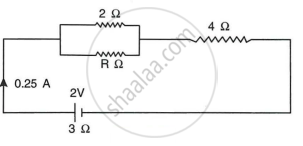
- the p.d. across the 4 Ω resistor,
- the p.d. across the internal resistance of the cell,
- the p.d. across the R Ω or 2 Ω resistors
- the value of R.
Three resistors of 6.0 Ω, 2.0 Ω and 4.0 Ω are joined to an ammeter A and a cell of emf 6.0 V as shown in the following figure. Calculate :
- the effective resistance of the circuit.
- the reading of ammeter.
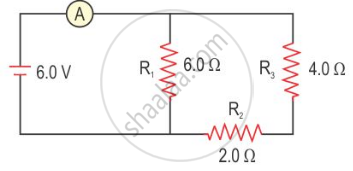
The diagram shows the arrangement of five different resistances connected to a battery of e.m.f. 1.8V. Calculate:
- the total resistance of the circuit, and
- the reading of ammeter A.

A cell of e.m.f. 2 V and internal resistance 1.2 Ω is connected to an ammeter of resistance 0.8 Ω and two resistors of 4.5 Ω and 9 Ω as shown in following figure.

Find:
- The reading of the ammeter,
- The potential difference across the terminals of the cells, and
- The potential difference across the 4.5 Ω resistor.
Selina solutions for Physics [English] Class 10 ICSE 8 Current Electricity EXERCISE - 8(C) [Pages 211 - 213]
Write an expression for the electrical energy spent in flow of current through an electrical appliance in terms of current, resistance and time.
Write an expression for the electrical power spent in flow of current through a conductor in terms of resistance and potential difference.
Write an expression for the electrical power spent in flow of current through a conductor in terms of current and resistance.
Electrical power P is given by the expression P = (Q × V) ÷ time. What do the symbols Q and V represent?
Electrical power p is given by the expression P = (Q × V) ÷ time. Express the power P in terms of current and resistance explaining the meaning of symbols used there in.
Name the S.I. unit of electrical energy. How is it related to Wh?
Explain the meaning of the statement 'the power of an appliance is 100 W'.
State the S.I. unit of electrical power.
State and define the household unit of electricity.
What is the voltage of the electricity that is generally supplied to a house?
What is consumed while using different electrical appliances, for which electricity bills are paid?
Name the physical quantity which is measured in kW.
Name the physical quantity which is measured in kWh.
Name the physical quantity which is measured in Wh.
Define the term kilowatt-hour and state its value in S.I unit
How do kilowatt and kilowatt-hour differ?
Complete the following:
1 kWh = `(1 "volt" xx 1 "ampere" xx "_________")/1000`
1 kWh = ______ J.
What do you mean by power rating of an electrical appliance? How do you use it to calculate the resistance of the appliance.
What do you mean by power rating of an electrical appliance? How do you use it to calculate the safe limit of current in it, while in use?
An electric bulb is rated ‘100 W, 250 V’. What information does this convey?
List the names of three electrical gadgets used in your house. Write their power, voltage rating and approximate time for which each one is used in a day. Hence find the electrical energy consumed by each in a month of 30 days.
Two lamps, one rated 220 V, 50 W and the other rated 220 V, 100 W, are connected in series with mains of 220 V. Explain why does the 50 W lamp consume more power.
Name the factors on which the heat produced in a wire depends when current is passed in it, and state how does it depend on the factors stated by you.
MULTIPLE CHOICE TYPE
When a current I flows through a resistance R for time t, the electrical energy spent is given by ______.
IRt
I2Rt
IR2t
I2R/t
An electrical appliance has a rating 100 W, 120 V. The resistance of element of appliance when in use is ______.
1.2 Ω
144 Ω
120 Ω
100 Ω
NUMERICALS
An electric bulb of resistance 500 Ω draws current 0.4 A from the source. Calculate:
- the power of bulb and
- the potential difference at its end.
A current of 3 A is passed through a coil of resistance 75 Ω for 2 minutes.
- How much heat energy is produced?
- How much charge is passed through the resistance?
Calculate the current through a 60 W lamp rated for 250 V. If the line voltage falls to 200 V, how is the power consumed by the bulb affected?
An electric bulb is rated '100 W, 250 V'. How much current will the bulb draw if connected to a 250 V supply?
An electric bulb is rated at 220 V, 100 W.
- What is its resistance?
- What safe current can be passed through it?
A bulb of power 60 W is used for 12.5 h each day for 30 days. Calculate the electrical energy consumed.
An electric iron is rated 750 W, 230 V. Calculate the electrical energy consumed by the press in 16 hours.
An electrical appliance having a resistance of 200 Ω is operated at 200 V. Calculate the energy consumed by the appliance in 5 minutes in joules.
An electrical appliance having a resistance of 200 Ω is operated at 200 V. Calculate the energy consumed by the appliance in 5 minutes in kWh.
A bulb marked 12 V, 24 W operates on a 12 V battery for 20 minutes. Calculate:
- The current flowing through it, and
- The energy consumed.
A current of 0.2 A flows through a wire whose ends are at a potential difference of 20 V. Calculate the resistance of the wire.
A current of 0.2 A flows through a wire whose ends are at a potential difference of 20 V. Calculate the heat energy produced in 1 minute.
What is the resistance, under normal working conditions, of an electric lamp rated at '240 v, 60 W' ? If two such lamps are connected in series across a 240 V mains supply, explain why each one appears less bright.
Two bulbs are rated 60 W, 220 V and 60 W, 110 V respectively. Calculate the ratio of their resistances.
An electric bulb is rated 250 W, 230 V. Calculate:
- the energy consumed in one hour
- the time in which the bulb will consume 1.0 kWh energy when connected to 230 V mains.
Three heaters each rated 250 W, 100 V are connected in parallel to a 100 V supply. Calculate:
- the total current taken from the supply
- the resistance of each heater and
- the energy supplied in kWh to the three heaters in 5 hours.
A bulb is connected to a battery of p.d 4 V and internal resistance 2.5 Ω. A steady current of 0.5 A flows through the circuit. Calculate:
- the total energy supplied by the battery in 10 minutes
- the resistance of the bulb and
- the energy dissipated in the bulb in 10 minutes.
Two resistors A and B of 4 Ω and 6 Ω respectively are connected in parallel. The combination is connected across a 6 volt battery of negligible resistance. Calculate the power supplied by the battery.
Two resistors A and B of 4 Ω and 6 Ω, respectively are connected in parallel. The combination is connected across a 6 volt battery of negligible resistance. Calculate the power dissipated in each resistor.
A battery of e.m.f 15 V and internal resistance 2 Ω is connected to two resistors of resistance 4 ohm and 6 ohm joined in series. Find the electrical energy spent per minute in 6 ohm resistor.
Water in an electric kettle connected to a 220 V supply took 5 minutes to reach its boiling point. How long will it take if the supply voltage falls to 200 V?
An electric toaster draws current 8 A in a circuit with source of voltage 220 V. It is used for 2 h. Find the cost of operating the toaster if the cost of electrical energy is ₹ 4.50 per kWh.
An electric iron is rated 220 V, 2 kW. If the iron is used for 3h daily find the cost of running it for one week if it costs ₹ 4.25 per kWh.
A geyser is rated 1500 W, 250 V. This geyser is connected to 250 V mains. Calculate:
- The current drawn,
- The energy consumed in 50 hours, and
- The cost of energy consumed at ₹ 4.20 per kWh.
Solutions for 8: Current Electricity
![Selina solutions for Physics [English] Class 10 ICSE chapter 8 - Current Electricity Selina solutions for Physics [English] Class 10 ICSE chapter 8 - Current Electricity - Shaalaa.com](/images/physics-english-class-10-icse_6:4c973dd038c545c9a2b6db170ad2f542.jpg)
Selina solutions for Physics [English] Class 10 ICSE chapter 8 - Current Electricity
Shaalaa.com has the CISCE Mathematics Physics [English] Class 10 ICSE CISCE solutions in a manner that help students grasp basic concepts better and faster. The detailed, step-by-step solutions will help you understand the concepts better and clarify any confusion. Selina solutions for Mathematics Physics [English] Class 10 ICSE CISCE 8 (Current Electricity) include all questions with answers and detailed explanations. This will clear students' doubts about questions and improve their application skills while preparing for board exams.
Further, we at Shaalaa.com provide such solutions so students can prepare for written exams. Selina textbook solutions can be a core help for self-study and provide excellent self-help guidance for students.
Concepts covered in Physics [English] Class 10 ICSE chapter 8 Current Electricity are Resistance (R), Ohmic and Non-ohmic Resistors, Choice of Material of a Wire, Superconductors, Electro-motive Force (E.M.F.) of a Cell, Terminal Voltage of a Cell, Internal Resistance of a Cell, Experimental Verification of Ohm’s Law, Electric Current, System of Resistors, Resistors in Parallel, Electric Circuit, Electric Charge, Limitations of Ohm’s Law, Ohm's Law (V = IR), Resistors in Series, Potential and Potential Difference, Electrical Power, Electrical Energy, Electrical Resistivity and Electrical Conductivity, Measurement of Electrical Energy (Expression W = QV = Vlt), Commercial Unit of Electrical Energy, Power Rating of Appliances, Household Consumption of Electric Energy, Effects of Electric Current, Heating Effect of Electric Current, Combination of Resistors - Series and Parallel, Factors Affecting the Resistance of a Conductor, Resistance (R), Ohmic and Non-ohmic Resistors, Choice of Material of a Wire, Superconductors, Electro-motive Force (E.M.F.) of a Cell, Terminal Voltage of a Cell, Internal Resistance of a Cell, Experimental Verification of Ohm’s Law, Electric Current, System of Resistors, Resistors in Parallel, Electric Circuit, Electric Charge, Limitations of Ohm’s Law, Ohm's Law (V = IR), Resistors in Series, Potential and Potential Difference, Electrical Power, Electrical Energy, Electrical Resistivity and Electrical Conductivity, Measurement of Electrical Energy (Expression W = QV = Vlt), Commercial Unit of Electrical Energy, Power Rating of Appliances, Household Consumption of Electric Energy, Effects of Electric Current, Heating Effect of Electric Current, Combination of Resistors - Series and Parallel, Factors Affecting the Resistance of a Conductor.
Using Selina Physics [English] Class 10 ICSE solutions Current Electricity exercise by students is an easy way to prepare for the exams, as they involve solutions arranged chapter-wise and also page-wise. The questions involved in Selina Solutions are essential questions that can be asked in the final exam. Maximum CISCE Physics [English] Class 10 ICSE students prefer Selina Textbook Solutions to score more in exams.
Get the free view of Chapter 8, Current Electricity Physics [English] Class 10 ICSE additional questions for Mathematics Physics [English] Class 10 ICSE CISCE, and you can use Shaalaa.com to keep it handy for your exam preparation.

